What makes the bowhead whale stand out in the animal kingdom? The answer lies in its remarkable adaptation to one of the most extreme environments on Earth – the icy waters of the Arctic. These gentle giants, with their impressive size and unique physiological features, have fascinated scientists and nature lovers alike.
The bowhead whale, a behemoth of the Arctic seas, maneuvers through ice-cold waters with astonishing agility. With a weight reaching up to 100 tons, these marine mammals are wrapped in a thick layer of blubber. This not only insulates them against the harsh cold but also provides a vital reserve of energy. Their body is uniquely tailored for life in the polar regions, notably marked by the absence of a dorsal fin – a testament to their evolution.
What truly sets these creatures apart, however, is their extraordinary lifespan; some individuals are believed to live more than 200 years. This aspect of their life has piqued interest regarding their biology and genetics. The bowhead whale exemplifies how nature crafts its inhabitants to flourish under the most severe conditions, offering a compelling narrative of survival and longevity.
Key Takeaways
In summary, the Bowhead whale showcases impressive evolutionary adaptations to thrive in the Arctic’s severe conditions. Its thick blubber layer and lack of a dorsal fin are tailored responses to extreme cold, underlining its special adaptations.
The species’ remarkable longevity is a subject of interest for studies on mammalian aging. With climate change posing a threat to its habitat, efforts to conserve the Bowhead whale become imperative.
Ongoing research is crucial for devising strategies to safeguard the Bowhead whale amidst environmental shifts, ensuring its survival in a changing world.
Scientific Classification
Bowhead Whale Classification and Ecology
Unraveling the Mysteries of Bowhead Whales
Bowhead whales fall under the expansive order Cetacea and the specific family Balaenidae. Their most notable trait is the possession of keratin baleen plates, which sets them apart from their cetacean relatives. These marine giants are part of the baleen whales group, or Mysticetes, renowned for their unique feeding technique. They filter small prey like zooplankton from the water, using their baleen plates, which is a key factor defining their role in the marine ecosystem.
The Significance of Taxonomy in Conservation
The precise classification of bowhead whales as Balaena mysticetus plays a crucial role in the scientific community. This classification aids researchers and conservationists in understanding their evolutionary background, physiology, and behavior, which is vital for developing effective conservation strategies. Being among the largest species in the Balaenidae family, bowhead whales are a focal point of marine research and conservation efforts.
Adaptations to Arctic Life
Bowhead whales have developed extraordinary adaptations, such as their sizable baleen plates, enabling them to prosper in the frigid Arctic and sub-Arctic waters. This adaptation not only showcases their evolutionary success but also highlights the importance of understanding the diverse marine environments they inhabit. Their ability to thrive in such harsh conditions underscores the significance of preserving these unique marine habitats.
Habitat

Adaptations to Extreme Cold
The remarkable ability of bowhead whales to thrive in the harsh conditions of the Arctic and subarctic waters is a testament to their evolutionary success. These waters, known for their extreme cold, serve as the perfect backdrop for the exploration of the bowhead whale’s unique physiological and behavioral adaptations.
One of the most notable is their capability to navigate and survive in an environment where temperatures can plummet dramatically. The cold waters aren’t just a backdrop but a critical component of their survival, directly influencing the availability and distribution of their prey.
Ice Navigation Skills
A standout feature of the bowhead whale’s adaptation is their unparalleled skill in breaking through thick sea ice. This ability isn’t merely a display of strength but a vital survival technique. It allows them to create breathing holes and access areas teeming with food sources beneath the ice’s surface.
This skill demonstrates a fascinating aspect of their interaction with their habitat, where the ice floes and thick sea ice not only present a challenge but also offer protection and resources.
Environmental Interactions
The interaction between bowhead whales and their Arctic habitat is complex and multifaceted. The cold waters and ice-covered landscapes they call home provide more than just a physical space. These elements offer protection from predators and shelter from the elements, playing a critical role in their survival strategy.
The ice floes, in particular, act as natural barriers, creating a safe haven for these majestic creatures against potential threats and extreme weather.
Diet
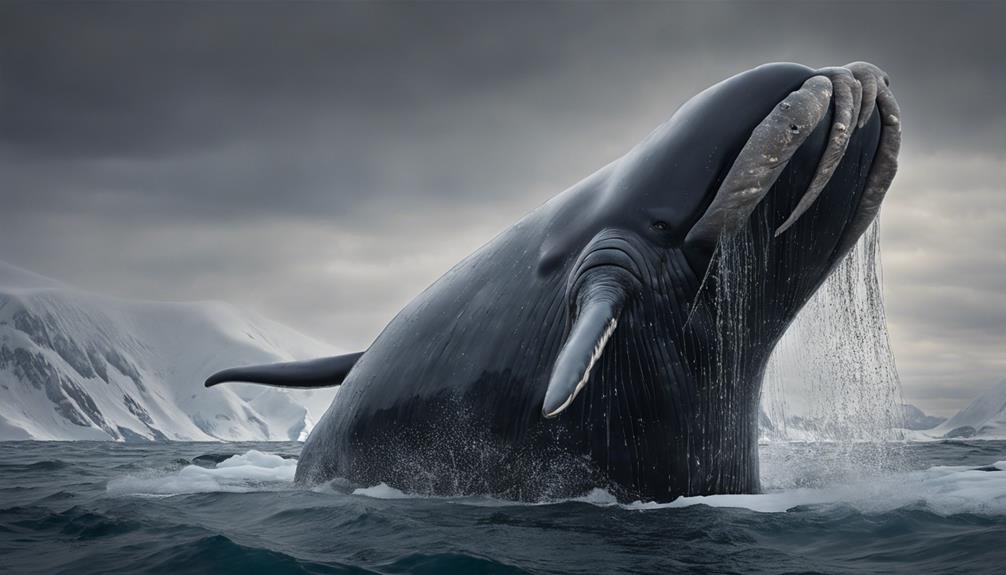
Gargantuan Appetites of Bowhead Whales
In the icy waters of the Canadian Arctic, bowhead whales showcase an extraordinary feeding routine to support their enormous size. These marine giants consume up to 2 tonnes of food daily, a feat that ensures their survival in the challenging Arctic conditions. Over the course of a year, this translates to an astounding 100 tonnes of nourishment, a testament to their incredible capacity for consumption.
Feeding Mechanism: A Natural Filtration System
Bowhead whales have evolved a unique method to feed in the dense Arctic waters. Their mouths house baleen plates, a natural filtration system that allows them to sift through the water for their prey. As they swim with their mouths agape, water flows through these plates, trapping marine invertebrates like copepods and krill. This efficient feeding strategy is perfectly suited to the nutrient-rich Arctic waters, enabling bowheads to capitalize on the abundance of food during the summer months.
Adaptations to the Arctic Diet
The diet of bowhead whales is a marvel of nature’s adaptation. By consuming a wide variety of marine invertebrates, these whales are able to meet their substantial energy requirements. Their specialized feeding technique highlights a remarkable adaptation to the Arctic environment, ensuring that they not only survive but thrive in the cold Canadian waters. This unique dietary habit underscores the bowhead whale’s extraordinary capability to harness the seasonal bounty of the Arctic for their sustenance.
Behaviour
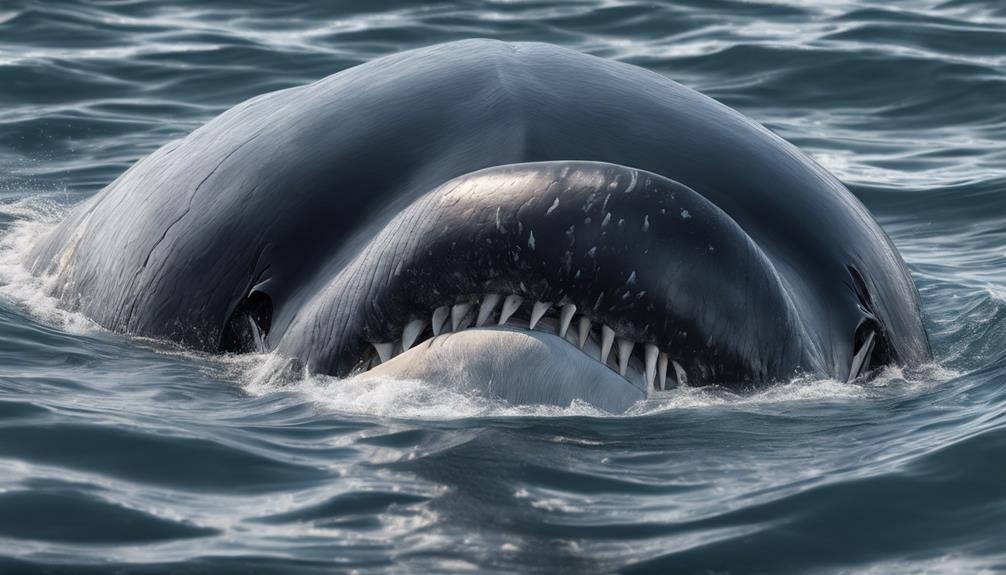
Exploring Bowhead Whale Social Interactions
Bowhead whales navigate the Arctic’s freezing temperatures with ease, a testament to their evolved behaviors and social interactions. These marine mammals are known for their dynamic activities such as breaching, tail slapping, and flipper slapping. Each movement isn’t just a display of physical prowess but also a medium for intricate communication among them. breaching emerges as a multifaceted behavior, possibly facilitating parasite removal, play, and communication.
Communication Through Sound
The ability of bowhead whales to communicate through complex vocalizations is nothing short of remarkable. Their survival in the icy waters heavily depends on this skill. They produce a variety of sounds, utilizing echoes to navigate and locate their food. This auditory communication is crucial for identifying and hunting marine invertebrates, their primary source of nourishment.
Feeding Techniques and Adaptations
Bowhead whales have uniquely adapted to their Arctic habitat through specialized feeding techniques. By filtering invertebrates through their baleen plates, they efficiently consume the necessary nutrients to thrive in such a harsh environment. Their adaptation extends beyond feeding habits, as seen in their physical characteristics. The absence of a dorsal fin is a notable adaptation that aids in navigating beneath ice sheets, further emphasizing their evolutionary prowess in the Arctic.
Conservation
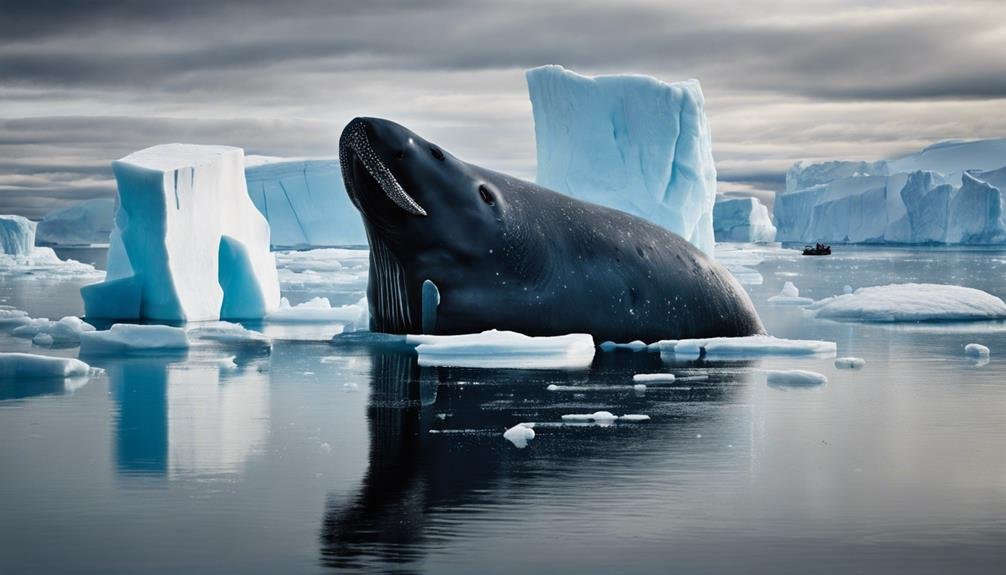
Threats to Bowhead Whales: Climate Change and Human Activities
Even though the IUCN Red List categorizes bowhead whales within the ‘least concern’ tier, they still confront significant dangers from oil drilling, shipping, and climate change. These activities not only threaten their survival but also disrupt the delicate balance of the Arctic marine ecosystems. The pressing need for a comprehensive conservation strategy is evident to counteract these human-induced threats.
Conservation Efforts: Sanctuaries and Noise Pollution Reduction
Leading the charge in bowhead whale conservation, organizations like the World Wildlife Fund (WWF) work in close collaboration with Native communities to establish whale sanctuaries. These protected areas are vital for providing refuge from the adverse effects of industrial activities, particularly in regions where bowhead whale populations are at risk. Additionally, initiatives aimed at curbing ocean noise pollution are crucial. Such pollution severely impacts the whales’ ability to communicate and navigate, which are critical functions for their survival and breeding.
Collaboration with Indigenous Communities
The partnership between conservation groups and Native communities underscores the value of indigenous wisdom in crafting effective protection strategies for the bowhead whale. This cooperative approach not only focuses on the immediate protection of the species but also emphasizes the importance of maintaining the health and stability of the Arctic marine ecosystems. Through these concerted efforts, there’s a strong push to secure a future for bowhead whales where they can thrive, free from the threats of climate change and human intrusion.
Climate Change Impacts
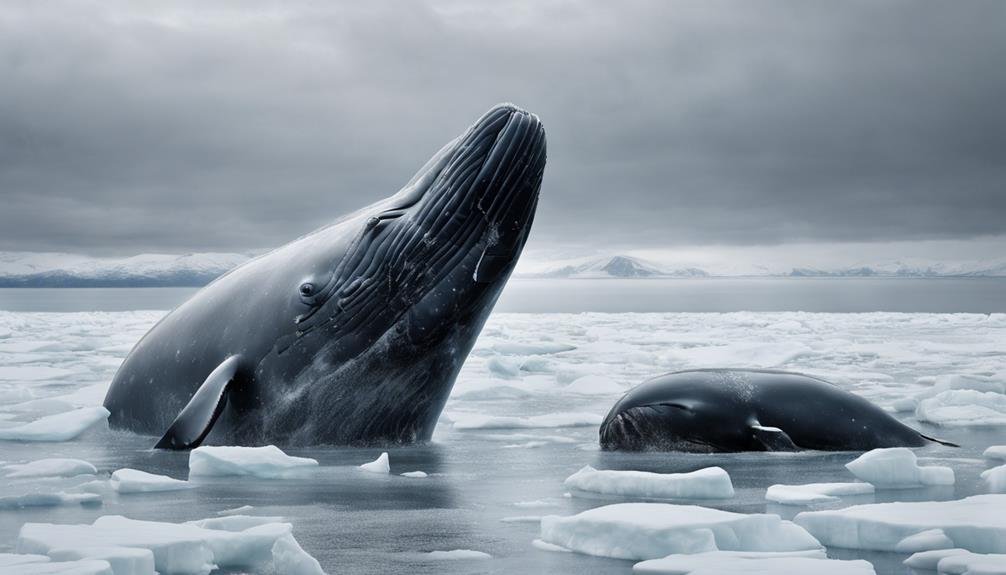
Climate change is significantly impacting bowhead whales, leading to a series of cascading effects on their habitat, behavior, and the broader Arctic marine ecosystem. Let’s delve into these impacts one by one, keeping our focus on the unique and interconnected challenges faced by these majestic Arctic inhabitants.
- Diminishing Sea Ice and Habitat Challenges: The retreat of sea ice, a direct consequence of climate change, is pushing bowhead whales into unfamiliar territories. Their once reliable ice-covered corridors, vital for migration and accessing food, are disappearing. This shift forces them into areas that may not provide the rich, nutrient-dense prey they depend on, posing a significant threat to their survival.
- Migration and Breeding Disruptions: The rhythm of the Arctic is changing, and with it, the life cycle of the bowhead whale. As sea ice vanishes earlier and forms later each year, these whales find their migration patterns out of sync with the seasonal availability of food and safe breeding grounds. Such disruptions can have long-term effects on the population dynamics of the species, affecting not only the number of calves born each season but also their survival rates.
- Changes in Prey Availability: The warming oceans and increasing acidification—a byproduct of climate change—are altering the distribution of krill and other prey species that bowhead whales feed on. These changes in the food web can lead to food scarcity, forcing whales to expend more energy searching for food, which can be particularly detrimental during the Arctic’s harsh winter months.
- Impacts on the Arctic Ecosystem: The plight of the bowhead whale is a harbinger for the broader Arctic marine ecosystem. As these whales navigate the challenges posed by climate change, their struggles reflect the interconnectedness of life in the Arctic waters. The health of the ecosystem, reliant on the balance between predators and prey, is in jeopardy as the foundational species like the bowhead whale face an uncertain future.
Other Interesting Facts
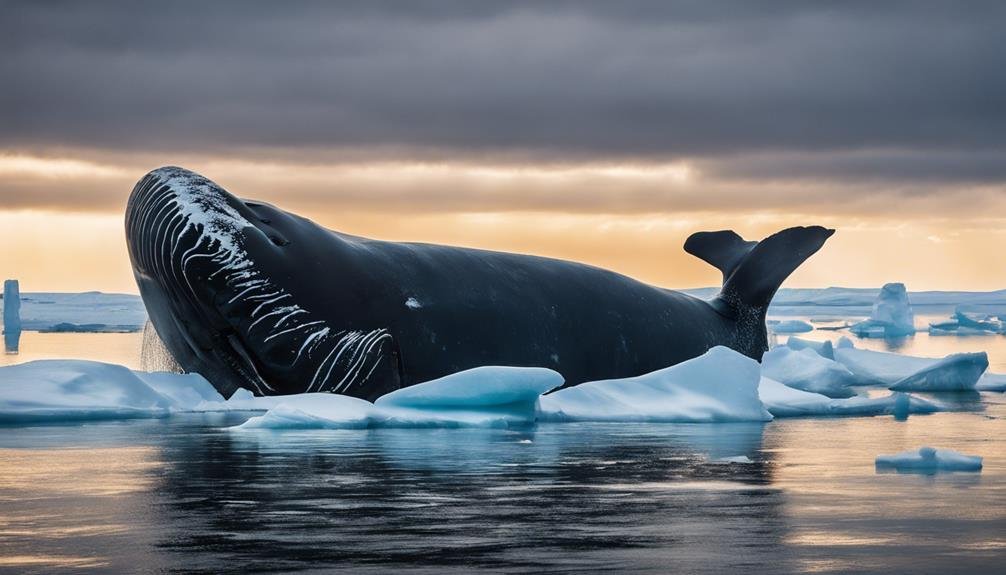
Unique Adaptations of Bowhead Whales
Bowhead whales, thriving in the frigid Arctic waters, have evolved unique characteristics that not only distinguish them from other marine species but also showcase their proficiency in surviving one of the planet’s most extreme environments. Their remarkable features are a testament to nature’s ingenuity in fostering life in all conditions.
Insulating Blubber: A Key to Arctic Survival
One of the most striking features of bowhead whales is their thick blubber, measuring up to 50 cm. This dense layer of fat isn’t merely for buoyancy but serves as a critical insulator against the bone-chilling temperatures of the Arctic seas. It’s a vital adaptation that enables these giants to navigate icy waters without succumbing to hypothermia.
Streamlined for the Ice
The absence of a dorsal fin in bowhead whales is a fascinating deviation from the norm seen in many marine mammals. This adaptation is far from coincidental; it allows them to glide smoothly under the ice sheets, minimizing heat loss and avoiding physical barriers that could impede their movement in the dense Arctic habitat.
Masters of Communication
Communication is key in the vast and often murky waters of the Arctic, and bowhead whales excel in this aspect. Their complex vocalizations aren’t just for social interactions but are crucial for navigation and locating prey in the dark, underwater world. These sounds reflect an advanced understanding of their acoustic environment, enabling them to thrive in conditions that would be challenging for other species.
A Testament to Resilience: Longevity
Bowhead whales are among the oldest living mammals, with some individuals living over 200 years. This incredible lifespan speaks volumes about their resilience and the effectiveness of their adaptations in coping with the harsh realities of their Arctic home. It also raises intriguing questions about the biological mechanisms underlying their longevity.
Cultural and Historical Significance
The relationship between bowhead whales and indigenous communities near Baffin Island is deeply interwoven, highlighting not only the whale’s importance in local ecosystems but also its role in human history and culture. The practice of subsistence whaling, regulated by the International Whaling Commission, underscores the respect and dependency these communities have on bowhead whales for their survival in the Arctic environment.
What is the similarity between bowhead whales and walruses in terms of their habitat or behavior?
Bowhead whales and walruses both inhabit the Arctic region, sharing similar habitats and behaviors. Fascinating walrus facts reveal that they are highly social animals, often found congregating in large groups, while bowhead whales are known for their lengthy migrations in cold waters. Both species rely on sea ice for feeding and reproduction.
Frequently Asked Questions
What Is Special About the Bowhead Whale?
Q: What makes the bowhead whale distinctive?
A: The bowhead whale is remarkable for its exceptional longevity, thriving in the Arctic with a large body and thick blubber for insulation. It has a specialized diet, engages in complex vocal communications, and holds great cultural value to indigenous communities.
Can Bowhead Whales Break Ice?
Q: Can Bowhead Whales Break Ice?
A: Yes, bowhead whales are adept at navigating through ice. They utilize their thick skulls and powerful breaching abilities to break through ice. This skill is particularly useful in their Arctic habitat, enabling them to migrate seasonally and reach feeding areas despite the icy obstacles.
Do Bowhead Whales Have Teeth?
Do Bowhead Whales Have Teeth?
Q: Do bowhead whales have teeth?
A: No, bowhead whales do not have teeth. They possess baleen plates which they use to filter food from the water. These baleen plates play a vital role in their diet, affecting their behavior, including how they communicate, migrate, and their longevity.
How Many Bowhead Whales Are Left?
Q: How many bowhead whales are left in the world?
A: There are between 10,000 and 15,000 bowhead whales remaining globally. Conservation efforts have led to a positive trend in their population. The health of this species is monitored by observing their habitats, migration patterns, reproduction rates, genetic diversity, and the effects of climate change.
What Are the Key Differences Between Bowhead Whales and Beluga Whales?
Bowhead whales and beluga whales differ in several ways, including size, habitat, and vocal behavior. Bowheads are larger and live in Arctic waters year-round, while belugas inhabit more varied environments. For more detailed beluga whale information, note that belugas are often called “sea canaries” for their diverse vocalizations.
Are Greenland Sharks a Threat to Bowhead Whales?
Greenland sharks and bowhead whales are two colossal Arctic species, but there’s no evidence suggesting that Greenland sharks pose a significant threat to bowhead whales. Experts continue to gather greenland shark information to better understand their behavior and diet in the icy depths, yet direct predation on large whales remains unconfirmed.
Conclusion
To sum up, the Bowhead whale demonstrates a fascinating evolutionary journey, adapting remarkably to the harsh conditions of the Arctic. Its substantial layer of blubber and the absence of a dorsal fin are nature’s solutions to the extreme cold, highlighting the whale’s unique adaptations.
The species’ extraordinary longevity also prompts further investigation into mammalian aging processes. With the looming threat of climate change affecting its natural habitat, preserving this species is more urgent than ever.
Continued research is vital for understanding how to protect the Bowhead whale against the accelerating changes in its environment, ensuring its continued existence in our rapidly evolving world.


